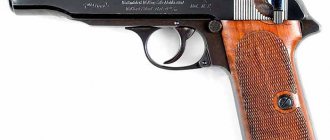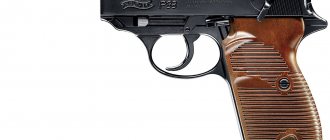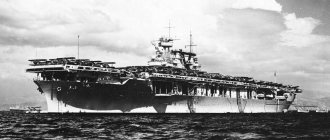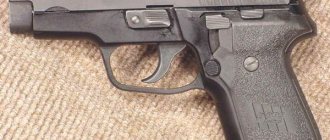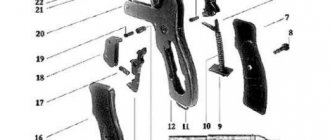US Army pistol
Home » Small arms of the past, present and future » Army pistol in the USA
Small arms of the past, present and future
boroda 10/22/2019 1944
13
in Favoritesin Favoritesfrom Favorites 6
Following the review of work on military pistols in our country, we will consider such work overseas, in the USA.
For more than half a century, the main pistol of the US Armed Forces (AF) was the classic model - the Colt M1911A1 caliber 11.43 mm (.45 ACP cartridge) designed by John Moses Browning. This pistol has become so widespread in the United States that it can be considered one of the symbols of America. The Colt M1911 pistol survived two world wars, the Korean and Vietnam Wars, and many other local conflicts.
One of the advantages of the Colt M1911 pistol is the high stopping power of the .45 ACP cartridge. Even in our time, despite the huge number of more modern models, pistols like the Colt M1911, produced by various manufacturers, are in great demand and are used for self-defense and practical shooting.
Classic Colt M1911 A1 US Army
Tactical and technical characteristics of the M1911 A1 pistol: Trigger mechanism (trigger): Single action. Safety: automatic, turns off when you wrap your hand around the handle, non-automatic on the frame. Caliber: .45 ACP (11.43mm). Magazine capacity: 7 rounds. Total length: 216 mm. Barrel length: 127 mm. Weight: 1075 gr.
Scheme of operation of the M1911 A1 pistol
However, in the second half of the 20th century, the Colt M1911 ceased to meet modern requirements. It uses a single-action mechanism that does not allow self-cocking firing and a small number of cartridges in a single-stack magazine. In this regard, the US armed forces in 1978 began work on selecting a new pistol to replace the Colt M1911 pistol and the Smith & Wesson M.15 revolver.
Another reason requiring the replacement of Colt M1911 pistols was the standardization of the 9x19 cartridge as a single NATO pistol cartridge (M882 cartridge).
Just as in Russia many are opposed to replacing the Makarov pistol in the army, believing that its characteristics fully satisfy the RF Armed Forces, so in the United States there were a huge number of opponents of the new army pistol. The invitation to foreign arms manufacturers to participate in the competition also caused rejection.
However, both American and European companies were invited to the competition, which took place in 1978-1980. Of the 25 samples of pistols from various companies, the following were selected: Smith & Wesson (USA) with model 459 and 459A pistols, Colt Industries with an SSP pistol, Beretta USA Corp. with the M-92 pistol, the Fabrigue Nationale company with the FN HP and BDA 9 pistols, and the Heckler und Koch (HK) company with the P9S, VP70 pistols and the PSP automatic pistol.
If European manufacturers won, they would have to organize production in the United States.
Clockwise from top left image - Smith & Wesson Model 459, Colt SSP, FN HP and FN BDA 9 (images may not be to scale)
Clockwise, starting from the top left image - Beretta M-92, HK P9S, HK PSP and HK VP70 (images may not be the same in scale)
The pistols provided to the US Army Pistol Competition by Heckler und Koch had a fairly original design. The HK P9S pistol used automatic action with a semi-blowback action and braking using a pair of rollers, like the G3 rifle. The HK VP 7 pistol was built on an advanced plastic frame for its time according to an automatic blowback design, which is rarely used in pistols chambered for a powerful cartridge. The striker trigger is cocked by pressing the trigger before each shot, which increases the force and reduces shooting accuracy.
And the HK PSP (P7) pistol used an automatic mechanism with a semi-blowback and braking by powder gases vented from the barrel. The striker trigger of the PSP pistol is equipped with a cocking lever located in the front part of the weapon handle. When the handle is grasped, the lever moves back, cocking the mainspring of the firing pin; when the lever is released, the firing pin is removed from the firing pin.
Scheme of operation of the NK PSP pistol
In general, one can note the Heckler und Koch company’s desire for non-standard solutions. Pistols from Smith & Wesson, Colt Industries, Fabrigue Nationale and Beretta had a classic design, however, according to test results, none of the pistols showed the necessary characteristics, primarily in terms of reliability in difficult conditions.
Based on this, a new competition was announced in 1981, to which pistols that showed the best results in previous tests were admitted. All applicants for the role of a US army pistol had to use the 9x19 cartridge, a self-cocking trigger and high-capacity magazines.
In the second competition, pistols were considered: Smith & Wesson model 459, Beretta M-92SB, Browning BDA-9P, Heckler und Koch P7A13 (upgraded PSP/P7) and SIG-Sauer P 226. The Beretta M-92SB pistol was again in the finals, but ultimately neither he nor the other contenders again completely satisfied the military.
In addition, the American Congress put pressure on the armed forces due to the significant financial resources required for rearmament. - Coolt Mfg Inc has proposed a low-cost alternative that consists of repairing and upgrading all 418,000 Colt M1911A1 pistols in service to 9x19 caliber. In fact, most of the pistol was changed - the barrel, bolt, magazine, ejector, reflector, bolt stop. However, the inspection showed that over 40% of Colt M1911A1 pistols are in such a worn-out condition that their modernization is impractical, and therefore the decision to switch to a new pistol was finally made.
The third stage of competitive testing was promptly carried out by the US Army from April to September 1984. Two pistols passed the tests - the modernized Beretta M-92F and the SIG-Sauer P 226. Ultimately, according to official data, the lower cost of the Beretta M-92F pistol inclined the military to choose this pistol, and in January 1985 the adoption of the pistol was officially announced Beretta M-92F as a standard model of personal weapons for all branches of the US armed forces under the symbol M.9. At the first stage, an order for 377,965 pistols was formed.
Finalists of the US Army Pistol Competition - SIG-Sauer P 226 and Beretta M92F
However, in 1987, a contract with Beretta USA Corp. was suspended after several accidents in which several shooters were injured as a result of the destruction of the bolt. By this time, about 140,000 pistols had already been produced. Beretta USA Corp. explained the failure of the bolts by simplifying the manufacturing technology during mass production, and recommended changing the bolt after 3000 shots, which of course did not suit the US Army.
Incidents with Beretta pistols gave Smith & Wesson reason to demand an additional competition. Repeated tests were carried out in August 1988. Smith & Wesson participated with an upgraded M.459 pistol, SIG-Sauer with a P 226 pistol with improved bolt guides, and Beretta USA Corp. introduced the M92FS pistol with a modified bolt. The new player was Sturm Ruger&Co with the P-85 pistol.
Pistol Sturm Ruger&Co P-85
According to the test results, all competing samples were again rejected, and Beretta USA Corp. a new contract was concluded for the supply of 500,000 M.9 pistols in addition to those previously purchased.
US Army pistol Beretta M.9 (Beretta M92FS)
Tactical and technical characteristics of the Beretta M.9 pistol: Trigger mechanism (trigger): Double action. Safety: non-automatic double-sided on the bolt casing. Caliber: 9x19 Para. Magazine capacity: 15 rounds. Total length: 217 mm. Barrel length: 125 mm. Weight: 1000 gr.
Operation diagram of the Beretta M.9 pistol (Beretta M92FS)
After the final adoption of the Beretta M.9 pistols, the issue of an army pistol was removed from the agenda in the US Army for a long time.
Over more than twenty years of service, Beretta M.9 pistols, as part of the equipment of American military personnel, have probably visited all the hot spots on the planet. During this time, when used in various climatic conditions, Beretta M.9 pistols proved to be reliable and high-quality weapons.
In 1989, the US Special Operations Command (SOCOM) began choosing a new pistol for its specific needs. They were not satisfied with the stopping effect of the 9 mm cartridge; preference was given to the .45 ACP caliber previously used by the US Army. Perhaps the 45 caliber turned out to be more preferable given the need for frequent use of weapons with a silencer. It is possible to significantly reduce the volume of a shot only if the shooting is carried out with subsonic ammunition. In this case, the large mass of the 11.43 mm bullet makes it possible to ensure a sufficiently high lethality of the weapon-cartridge complex when using a silencer and subsonic bullet speed.
At the competition for a promising pistol for special operations forces (SSO), only two options were considered - a modernized pistol based on the classic Colt M1911 model and a new pistol from the German company Heckler und Koch based on the HP USP model. The competition was officially launched in 1991, and in 1996, Heckler und Koch already began supplying the SOCOM pistol under the official designation Mark 23 Model 0 US SOCOM Pistol.
Pistol Mark 23 Model 0 US SOCOM
Pistol Mark 23 Model 0 US SOCOM
The Mark 23 Model 0 US SOCOM pistol is a complex that includes, in addition to the pistol itself, a silencer and an aiming unit. The sighting unit consists of a built-in tactical flashlight and two laser designators, one of which operates in the visible range and the other in the infrared spectrum, for use in conjunction with a night vision device. The design of the Mark 23 pistol is based on the HK USP pistol. The pistol frame is polymer, the bolt casing is made of chrome-molybdenum steel, which is then treated with nitriding and oxidation to protect against corrosion. The pistol frame and controls are optimized to allow shooting with gloves.
The double-row magazine holds 12 rounds of 11.43 mm caliber. The pistol can fire ammo with a reinforced charge. Trigger-type trigger, double action, with a trigger force with a pre-cocked trigger of 2 kg, in self-cocking mode 5.5 kg. There is a double-sided safety switch with two on/off positions. In front of the safety, on the left side of the frame, there is a lever for safely decocking the hammer.
The Mark 23 pistol has a lifespan of 30,000 rounds. Pistol length 245 mm, width 39 mm, height 150 mm, weight without cartridges 1100 g. The Mark 23 pistol turned out to be very large and quite heavy, which is why many fighters, given a choice, prefer the less massive HP USP Tactical pistol.
HP USP pistol operation diagram
Thus, based on the results of a long selection process, the US armed forces, in the period from 1988 to 1996, received at their disposal both the main army pistol and a pistol for special forces.
You can pay attention to the fact that approximately a similar practice has developed in the Russian armed forces, where the Yarygin pistol was adopted for the army, and the special forces actually preferred the Serdyukov “Gyurza” self-loading pistol chambered for a more powerful cartridge. However, while in the United States the emphasis is on stopping power, in Russia they prefer increased armor penetration.
In 2015, the US Armed Forces (AF) announced a long-awaited competition for small arms manufacturers to select a new XM17 military pistol, the MHS (Modular Handgun System) program.
How necessary was a new pistol for the US Army? After all, the Beretta M-92FS (designated M.9 in the US Armed Forces) is not such an outdated weapon? The main reason for this program is the same as the replacement of the Colt M1911 A1 with the Beretta M.9. Over the 15-20 years that the Beretta M.9 pistols have been in service, many of their elements could have worn out quite seriously, of course, provided that they are not in storage awaiting a world war, but are actively used, at least for training purposes. Of course, some elements, such as the barrel, springs, pins and others, can be replaced, but the complexity of diagnostics and repairs, with the replacement of worn-out components, can be quite high and financially burdensome. Another option - purchasing additional batches of M.9 pistols is also ineffective, since experience is accumulated during operation, the requirements for an army pistol change, and manufacturers offer new design solutions.
Requirements for a new army pistol began to be developed in 2008 and include a modular design, ensuring the ability to replace pistol elements for shooters with different hand sizes. The controls should be ambidextrous, allowing both right- and left-handed people to use them comfortably. The pistol must be equipped with guides for attaching under-barrel accessories and various types of sights. The coating of the gun should not be slippery or glare.
Pistols must be accurate enough to hit a 4-inch target at 50 meters 90 percent of the time throughout the life of the weapon. Each proposal was required to include two pistols - one full-size, one compact, or one pistol that satisfied both the full-size and compact model requirements.
According to the requirements of reliability and durability, the proposed pistols must provide at least 2,000 shots without delay, at least 10,000 shots before malfunctions occur, and guarantee a barrel life of up to 35,000 shots.
The owner's manual for a new military pistol should detail all the steps necessary to operate the pistol and modify its ergonomic components. The design of the pistol should exclude the possibility of its complete disassembly by untrained users (read soldiers). Complete disassembly must be carried out by a specialist gunsmith of the unit, using special tools.
An interesting point, despite the fact that the US Army uses the standard NATO 9x19 cartridge, there were no strict caliber/cartridge requirements for the pistol under the MHS program. Due to complaints from military personnel about the lack of lethality of the 9x19 cartridge when using pistols of this caliber in combat zones such as Iraq and Afghanistan, manufacturers were able to offer weapons in other calibers such as .40 S&W .45 ACP, .357 SIG, FN 5, 7x28 mm.
In addition, the possibility of using expansive and fragmenting bullets in the new army pistol was considered. The United States did not sign the Hague Convention of 1899, prohibiting their use in hostilities, although it has complied with it to date. It is believed that the use of expansive and fragmenting bullets in the 9x19 cartridge will increase its stopping and damaging effect without switching to another caliber.
As with previous attempts to replace the military pistol in 1978-1988, obstacles arose. The US House Armed Services Committee called for the MHS program to be canceled and the Beretta M.9 pistol to be upgraded instead. The Beretta company, wanting to be guaranteed to remain the main supplier of military pistols to the US Army, even before the official start of the MHS program was announced, presented in December 2014 a modernized Beretta M9A3 pistol, partially meeting the requirements of the US Armed Forces for a new pistol.
The Beretta M9A3 pistol is a further development of the Beretta M.9/M-92FS model. It is equipped with guides under the barrel, a replaceable front sight, and a handle with a smaller reach. In the muzzle of the barrel there is a thread with a removable protective sleeve, designed for installing a quick-release muffler.
Beretta M9A3 pistol
Tactical and technical characteristics of the Beretta M9A3 pistol: Caliber: 9x19 mm; Magazine capacity: 15 rounds;
Barrel length: 125 mm; Total length: 216 mm; Weapon height: 137 mm; Weight without cartridges: 961 g.
However, Beretta's proposal was rejected, the US House of Representatives approved the cost of a new pistol, and in August 2015, the US military officially announced the start of the MHS program, indicating the cost of the program in the amount of $580 million. Testing of the pistols was planned to take place before the end of 2022, and starting in 2022, the winner would supply the US military with 280,000 standard M17 pistols for the military, replacing the Beretta M.9, 212,000 M17 pistols for other services, and 7,000 compact versions of the M18.
In total, pistols provided by eight weapons companies were selected for testing.
The Beretta company sent a new APX pistol to the competition. The Czech company Ceska zbrojovka participated with the compact CZ P-07 pistol and the full-size CZ P-09 in 9x19 and .40 S&W caliber. The American branch of FN America LLC of the Belgian company Fabrique Nationale presented the FN 509 pistol, specially designed for the requirements of the MHS program.
The Sphinx company presented the SDP pistol for the competition. Austrian Glock participated with pistols Glock 19 MHS chambered for 9x19 and Glock 23 MHS chambered for .40 S & W. SIG Sauer presented the P320 MHS in full-size and compact versions. American companies participated - Smith & Wesson with the M&P M2.0 pistol, STI-Detonics with the STX pistol.
According to some reports, pistols from Heckler & Koch, Springfield Armory, Taurus and Walther were also considered as contenders, but they did not officially take part in the competition.
Since the Beretta M9A3 pistol did not have a compact version, and for a number of parameters it did not meet the requirements of the MHS competition, the Beretta company participated with the new APX pistol. Presumably this pistol was developed specifically to meet the requirements of the MHS program, including a modular design. According to the requirements of the MHS program, the Veretta APX is equipped with a non-automatic safety, while for civilian use there is a version only with an automatic safety, like on Glock pistols.
The Beretta APX pistol uses an automatic short-stroke barrel and locks it with a skewed breech. The bolt is made of stainless steel, the pistol frame is made of impact-resistant polymer, the trigger is striker-operated, with pre-cocking of the hammer by the bolt and additional cocking when the trigger is pressed.
Presumably, one of the factors that played against the Beretta APX pistol was the absence at the beginning of the MHS program of mass production of these pistols and their sales to any law enforcement agencies.
Beretta APX pistol
Tactical and technical characteristics of the Beretta APX pistol: Caliber: 9x19 mm; Magazine capacity: 17 rounds; Barrel length: 085 mm; Total length: 192 mm; Weapon height: 142 mm; Weight without cartridges: 760 g.
The CZ P-07 and P-09 pistols, presented to the competition by Ceska zbrojovka, are based on the design of the CZ-75 pistol, which is well known to athletes involved in practical shooting. The pistols are based on a polymer chassis with a steel slide and have a new (relative to the CZ-75) Omega double-action trigger trigger with a smoother trigger pull. Automation is based on the use of recoil with a short stroke of the barrel, locking is carried out using a descending breech of the barrel. The controls and shape of the pistol are optimized for use with gloves.
According to user reviews, the gun is comfortable and accurate. Apparently, the US Army was not satisfied with the modularity of the CZ P-07 and P-09 pistols, which consisted only in the possibility of replacing the rear part of the handle, which is probably why Ceska zbrojovka refused to officially participate in the competition.
Pistol CZ P-09
Tactical and technical characteristics of the CZ P-09 pistol: Caliber: 9x19 mm; Magazine capacity: 19 rounds; Barrel length: 112 mm; Total length: 210 mm; Weight without cartridges: 862 g.
FN America LLC entered the MHS competition with one pistol, the FN 509, which was offered as both a full-size and a compact version. The pistol frame is polymer. The automatic operation of the pistol works according to the scheme of using the recoil of the movable barrel during its short stroke, locking it with the help of a descending barrel, and engaging the upper protrusion of its breech with an enlarged window for ejecting spent cartridges. The USM is striker-fired, with a pre-cocked firing pin.
As with the CZ P-07 and P-09 pistols, the FN 509 pistol does not feature a modular design.
Pistol FN 509
FN 509 pistol with a silencer, a collimator sight, an under-barrel flashlight and an extended magazine
Tactical and technical characteristics of the FN 509 pistol: Caliber: 9x19 mm; Magazine capacity: 17 rounds; Barrel length: 102 mm; Total length: 188 mm; Weapon height: 141 mm; Weight without cartridges: 762 g.
The data on the Swiss Sphinx SDP pistol varies; according to some sources, both the full-size version and the Compact version were involved, according to other sources, only the Compact version, which, however, is not so important. Sphinx pistols trace their lineage to the CZ 75 pistol, and the SDP model was no exception; accordingly, its design is similar to that of its progenitor, with minor changes. This pistol has no modularity, and the price is probably higher than competitors (a price for high quality workmanship), so the probability of victory for this model was minimal from the very beginning.
Sphinx SDP Compact pistol
Tactical and technical characteristics of the Sphinx SDP Compact pistol: Caliber: 9x19 mm; Magazine capacity: 15 rounds; Barrel length: 95 mm; Total length: 190 mm; Weapon height: 140 mm; Weight without cartridges: 780 g.
The Austrian company Glock made unimaginable sacrifices for the sake of the MHS competition, releasing versions of its pistols with a non-automatic safety (previously this was done only according to the requirements of the “native” Austrian army). Due to the fuse, the thickness of the pistols increased by 2 mm.
Initially, it was assumed that the competition would include pistols Glock 17/Glock 19 in 9x19 caliber and Glock 22/Glock 23 in .40S&W caliber. However, the Austrians surprised everyone by introducing, so to speak, “hybrid” versions of these models - Glock 19 MHS and Glock 23 MHS. So the Glock 19 MHS corresponds in height to the Glock 17, and in the length of the barrel and body to the Glock 19. Accordingly, for the Glock 23 MHS these are the dimensions of Glock 22 and Glock 23. The front faces of the slides of both pistols are made in a beveled form, similar to the type of subcompact slides - Glock 26/ Glock 27. The pistols are coated with a protective non-reflective coating.
Glock MHS pistol magazines are not compatible with civilian models due to the protective lip on the grip. For each pistol there is a standard capacity magazine - 17 9x19 rounds or 15 .40S&W rounds, and an increased capacity - 19 9x19 rounds or 22 .40S&W rounds, with a cover protruding beyond the handle. The magazine neck is widened for faster installation of a new magazine, and there is a removable swivel at the rear. Otherwise, for the most part, it’s still the same “good old” Glock.
The main reason for the rejection of Glock MHS pistols is again considered to be non-compliance with weapon modularity requirements. Looking ahead, Glock filed a protest, believing that the capabilities of its pistols were underestimated compared to its winning competitor, but the protest was rejected.
Glock 19 MHS pistol
Tactical and technical characteristics of the Glock 19 MHS pistol: Caliber: 9x19 mm; Magazine capacity: 17 or 19 rounds; Barrel length: 102 mm; Total length: 185 mm; Weapon height: 138 mm; Weight without cartridges: 708 g.
The American company Smith & Wesson participated with the M&P 2.0 (Military and Police) model. The pistol frame is made of Zytel polymer with steel inserts, the automation is based on the use of recoil energy with a short barrel stroke, and the barrel is locked according to the Browning scheme. The barrel, bolt and other metal parts are made of stainless steel, the trigger trigger is double-action only. The pistol grip is modular and has a removable back part.
Despite the fact that the S&W M&P pistol is actively used by law enforcement agencies in the United States and other countries of the world, its design is also not modular in accordance with the requirements of the MHS program. As a result, Smith & Wesson voluntarily refused to participate in the competition.
Pistol S&W M&P 2.0
Tactical and technical characteristics of the S&W M&P 2.0 pistol: Caliber: 9x19 mm; Magazine capacity: 17 rounds; Barrel length: 108 mm; Total length: 188 mm; Weapon height: 140 mm; Weight without cartridges: 734 g.
S&W M&P pistol operation diagram
The second American company STI participated with the STX pistol. The STX pistol chassis is made of 7075 aluminum alloy with a polymer coating. The shutter is made of steel. The pistol frame supports four different barrel and slide lengths, and there are two frame sizes to accommodate people with different hand sizes. The STI STX pistol was withdrawn from the MHS competition without explanation.
Pistol STI STX
Tactical and technical characteristics of the STI STX pistol: Caliber: 9x19 mm;
Magazine capacity: 17 rounds; Total length: 178 (201) mm;* Weight without cartridges: 652 (1020) g.* * - different sources give different sizes and weights of the STI STX pistol, perhaps the data is given for weapons with different lengths of the barrel and bolt-casing. Presentation of the STI STX pistol
Well, we finally come to the winner. The US Armed Forces announced on January 19, 2022 that the winner of the competition under the MHS program was the SIG Sauer pistol model P320 in full-size and compact versions. A contract worth $580.217 million will be signed with SIG Sauer. In the US Army, the pistol will be designated M17 for the full-size version and M18 for the compact version.
SIG Sauer M17 and M18 pistols
Tactical and technical characteristics of the SIG Sauer M17 pistol: Caliber: 9x19 mm; Magazine capacity: 17 rounds; Barrel length: 119 mm; Total length: 203 mm; Weapon height: 134 mm; Weapon thickness: 35.5 mm Weight without ammunition: 833 g.
The original SIG Sauer P320 has the most modularity of all presented samples. The trigger can be inserted into frames of various sizes (full-size, compact, subcompact), with slides of various lengths and barrels of various lengths and calibers - 9x19, .357SIG, .40 S&W and .45 ACP.
Frames, bolt casings, barrels of the modular set SIG Sauer P320
The replacement frame of the M17 and M18 pistols is polymer, but includes a removable metal base with trigger parts and guides for the bolt, so the movement of the bolt-casing and barrel does not lead to wear of the polymer frame. The weapon number is stamped on a metal base; a slot is made in the frame so that this number is visible.
Metal base of M17, M18 pistols
Pistols use an automatic mechanism with a movable barrel and a short stroke, with locking by skewing the breech of the barrel. The USM is striker-operated, with preliminary partial cocking. Complete assembly and disassembly of the M17 and M18 pistols require special tools, as specified in the terms of the MHS program.
The M17 and M18 pistols are equipped with ambidextrous manual safeties and frame-mounted slide stop levers. The magazine release can be installed on either the left or right side. The rear sight is mounted on a special removable platform on the pistol's slide-casing. Instead of a platform with a rear sight, compact collimator sights can be installed, including those compatible with night vision devices. Pistols can be equipped with extended barrels with threads for installing a silencer.
Collimator sight on the slide of the SIG Sauer M17 pistol, installed instead of a platform with a rear sight
The length of the handles and the magazines used are the same for the M17 and M18 pistols. Pistols are delivered to the troops assembled, equipped with two additional replaceable plastic frames with handles in sizes L, M and S, that is, large, medium and small.
Delivery kit for SIG Sauer M17 and M18 pistols
In January 2022, it was reported that a Connecticut State Police officer was injured due to an accidental discharge when his P320 fell to the ground. This problem also affected P320 pistols sold on the civilian market, but according to SIG Sauer, this problem has been eliminated in the M17 and M18 pistols, and should now be resolved in “civilian” models.
Information has also appeared about some other problems with the SIG Sauer M17, M18 pistols, such as random shots, ejection of unfired cartridges (double ejection - when the following unspent ammunition was ejected along with the cartridge case during shooting), frequent delays when using bullets with a full metal jacket . According to some sources, the listed problems occurred in the initial phase of testing and were eliminated in mass-produced weapons; according to other sources, these problems were identified by servicemen from combat units that had already received new pistols.
On the other hand, given the number of pistols sold by SIG Sauer, the problems are unlikely to be widespread, and it is necessary to look for their root causes. After all, no one has yet managed to create a structure that another cannot break.
Video of US military personnel unpacking and firing SIG Sauer M17 pistols
What conclusions can be drawn?
Compared to the first competition to select an army pistol, which lasted almost ten years, the MHS competition was held in less than two years, with almost no scandals, except for the Glock company complaint. However, who knows what will happen in six months or a year, if the problems do not stop, it is quite possible that the results will be canceled and the selection will begin again...
There is a feeling that some companies participated in the competition under the MHS program “for show.” It seems like there is a competition, and there are participants, but there is no competition as such, or they either withdrew or were rejected for unknown reasons. In Russia, the topic of a “fake” tender is quite well known, when the terms of reference (TOR) are adjusted in such a way that only one supplier can comply with them. It is likely that the stronghold of democracy has also been familiar with this scheme for a long time. In the end, Glock was not chosen, was it a conspiracy?
On the other hand, we cannot exclude the possibility that the participating companies and the customer (US Armed Forces) sign an agreement on the confidentiality of the test results of the competition so that the revealed shortcomings of a particular type of weapon do not reduce sales to other departments and private buyers.
Unlike the 1978-1988 army pistol competition, all manufacturers offered models of classic designs. No removal of powder gases, no rotating barrels, no automatic fire and other exotic things.
In any case, the technical specifications for a new type of weapon are a set of compromises between the desired characteristics and the capabilities of suppliers. A company that can produce a limited batch of a structurally ideal pistol may not be able to launch large-scale production of it. The desire to change the caliber to a more effective one comes across warehouses filled with cartridges of the caliber in use.
Taking into account the above, the US armed forces received a decent pistol (set) capable of satisfying their needs for this type of weapon for the coming decades.
Sources:
https://topwar.ru/156593-armejskij-pistolet-v-ssha-chast-1.html
https://topwar.ru/156747-armejskij-pistolet-v-ssha-chast-2.html
Glock 17
The best pistols in the world are headed by the Austrian model, which was developed in 1982 specifically for the local army. At that time, manufacturers did not think that they were creating the perfect weapon, which after more than 40 years would remain a leader among competitors from different countries and continents. It does not have a safety box or trigger, which can be confusing. In fact, this is the main advantage of this type. It is made of durable plastic with heat resistance up to 200 degrees. Durability added to its advantages and is another reason why the Glock 17 is the best pistol in the world and has held this position for so long. Today the cost per unit reaches $600. It was adopted for service during the years of production.
- Country: Austria
- Length: 20.4 cm
- Barrel: 11.4 cm
- Caliber: 9 mm
- Bullet speed: 375 m/s
- Sighting range: 50 m
- Magazine: up to 23 rounds
- Weight: 625 g
Colt M1911
Another best pistol in the world today, which is recognized in any state. In 1908, it was developed by John Moses Browning and put into service with a number of US troops. He officially entered the army in 1911. The weapon is made of 53 elements that must be disassembled. Even now it is much more popular and famous than most modern models. The shutter moves along a guide located in the frame. The barrel itself is combined with the frame by a swing-type earring. Top 10 best pistols in the world 2021 will not be able to do without it for a long time.
- Country: USA
- Length: 21.6 cm
- Barrel: 12.7 cm
- Caliber: .45 ACP
- Bullet speed: 280 m/s
- Sighting range: 27 m
- Magazine: up to 7 rounds
- Weight: 1120 g
FN Five-Seven
These are the same pistols in service with the Belgian army at the moment. Compared to competitors, one of the freshest. It was accepted into service in 2000, and developed in 1998. One of the main differences between the weapons is the choice of caliber and 5.7 mm cartridges. It is made according to the semi-free shutter design, like many others, polymers are used here as a material. Despite the choice of caliber, the Belgian best pistols in the world 2021 exceed 20 centimeters in length and that’s quite a lot. True, this did not affect the overall mass in any way.
- Country: Belgium
- Length: 20.8 cm
- Barrel: 12.2 cm
- Caliber: 5.7 mm
- Bullet speed: 520 m/s
- Sighting range: 50 m
- Magazine: up to 30 rounds
- Weight: 610 g
Desert Eagle
The best pistol in the world when it comes to appearance. Every man dreams of one day holding in his hands this magnificent specimen, which has become widespread almost everywhere. His are not only the best pistols in service with the army , but also in games, filming and more. It was developed in 1983 jointly by Americans and Israelis. At the moment, the cost per unit of Desert Eagle can reach $2,000. One of the main features of such weapons is usually called the firing range and at the same time accuracy. These best pistols in the world 2021 have enormous power and a menacing appearance. The only downsides that stand out are its impressive dimensions and recoil.
- Country: USA and Israel
- Length: 26.9 cm
- Barrel: 15.2 cm
- Caliber: .357 Magnum, .44 Magnum and .50 Action Express
- Bullet speed: 580 m/s
- Sighting range: 50 m
- Magazine: up to 9 rounds
- Weight: 1700 g
(Visited 1,328 times, 3 visits today)
TT
Pistols of the Russian Army 2021 can naturally be proud of the Tula Tokarev, because he is famous and is among the best pistols in the world . In the USSR, it became the first self-loading weapon of this type in history. The model was put into service already in the 1930s, and it was a huge breakthrough that the Americans envied. First of all, it is good for its simple design, which can be easily disassembled and reassembled at any time. In addition, it attracted with its favorable price. Otherwise, the best pistol in the world today from Russia uses powerful cartridges to fire, thanks to which it produces up to 500 Joules of muzzle energy. Some doubt its safety, and this is the case.
- Country Russia
- Length: 19.5 cm
- Barrel: 13 cm
- Caliber: 7.62 mm
- Bullet speed: 420 m/s
- Sighting range: 50 m
- Magazine: up to 8 rounds
- Weight: 854 g
Walther P99
Most agree that the top three and best pistols in the world 2021 should have included a German copy, which everyone knows by the word Walter. Recoil with a short barrel stroke is the basis of the action of this type of small arms. The frame is made of polymer materials; there is an option to choose the Walther P99 in black or green. A special button is used to decock the firing pin. Automatic fuses have an indicator that notifies you of the presence of a cartridge in the chamber. The rating of world pistols has been familiar with Walter since 1996, when it was adopted by the local service. Today it is in many European armies and is well known in Ukraine.
- Country: Germany
- Length: 18 cm
- Barrel: 10.2 cm
- Caliber: 9 mm
- Bullet speed: 375 m/s
- Sighting range: 50 m
- Magazine: up to 16 rounds
- Weight: 700 g
Beretta 92
Top 10 best pistols in the world 2021 could not do without Beretta, the legendary “gun”. The developer of this model was officially Carl Beretta himself and his team. Experienced craftsmen worked for the Italian company and were able to go down in history thanks to such cool weapons. It didn't take long for the barrel to make its way into US Army pistols . At one time, more than a million units were purchased in America. This copy is recognized in any country; it is one of the most popular. It is in great demand not only among police officers, but also among military personnel themselves. Some of it went into circulation on the civilian market. The best pistols in the world work thanks to recoil and a short barrel stroke. The unit consists of 65 parts, the return spring is located under the barrel itself.
- Country: Italy
- Length: 21.7 cm
- Barrel: 12.5 cm
- Caliber: 9 mm
- Bullet speed: 390 m/s
- Sighting range: 50 m
- Magazine: up to 15 rounds
- Weight: 950 g
HK USP
The best pistol in the world must meet all parameters and, first of all, be distinguished by survivability. This quality can easily be attributed to the HK USP, originally from Germany, adopted for service in 1993. It is used in both the police and the army due to its accuracy, accuracy and reliability. A copy is produced for the classic 9 mm Parabellum cartridges. The best pistol in the world today is characterized by large dimensions and many call this a disadvantage. It was developed only to replenish the pistols of the US Army and, in general, it succeeded. But the model quickly spread to many other states.
- Country: Germany
- Length: 19.4 cm
- Barrel: 10.8 cm
- Caliber: 9 mm
- Bullet speed: 350 m/s
- Sighting range: 50 m
- Magazine: up to 15 rounds
- Weight: 748 g
Sig-Sauer P226
The best pistol in the world was created specifically for a competition held by the Americans. The weapon first entered service in 1983; it is a joint development of the Swiss and Germans. The automation in this example is triggered according to a standard barrel recoil pattern with a short stroke. Everyone knows about the Sig-Sauer P226 as a powerful and reliable option that can demonstrate excellent accuracy. the Top 10 best pistols in the world 2021 for a long time, although during the first competition in history it was rejected by the Americans. Today there are such pistols in service with the armies of Israel, Kazakhstan, Poland, France and some other countries.
- Country: Germany and Switzerland
- Length: 19.6 cm
- Barrel: 11.2 cm
- Caliber: 9 mm
- Bullet speed: 250 m/s
- Sighting range: 50 m
- Magazine: up to 20 rounds
- Weight: 802 g



